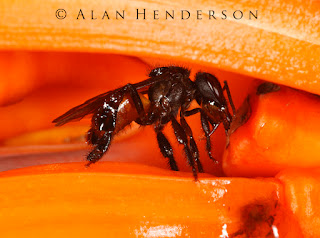Ctenidae is a family of moderate to large spiders which dominate the spider fauna in
Costa Rica, much the same way as the Sparassids (huntsmen) do in
Australia. Ctenids are known as wandering spiders and have a very distinctive eye arrangement; they basically have a row of six across the top and two below. Viewed from the front they have four large forward facing eyes which make them quite easy to identify.
 |
| Cupiennius sp. |
 |
| A large ground-dwelling Ctenid |
 |
| Another large ground dweller we have nicknamed the 'Leopard wandering spider due to the spots on the legs. |
Some species are very much like huntsman in their hunting methods and speed of movement, whilst others hunt on the ground and are more like over-sized wolf spiders. As their common name suggests, they tend to be wanderers, although I have noticed that some species tend to favour a territory and I will see them each night in much the same place. Their hunting technique basically relies upon ambush; pouncing on their prey with speed and power. So far I have witnessed them feeding on moths, katydids, other spiders and frogs.
 |
| A Ctenid spider feeding on a katydid |
There are a number of large species around the
Osa Peninsula, and we have encountered four here where we are staying. One of the most notable is known a Brazilian Wandering Spider (
Phoneutria reidyi). It is a very large spider and has extremely potent venom. I have already heard several stories of locals being hospitalised in excruciating pain from the bite of this species. I have found two of these spiders in my boots, and on one occasion I was just about to slip my bare foot in when I spotted it.
 |
| Phoneutria reidyi |
Another common Ctenid is the Red-thighed wandering spider (
Cupiennius sp.) This is the size of a large huntsman, but more unpredictable in its movement and believe it or not, even faster than most huntsmen I have worked with. We used this species in the studio recently, and it was challenging to keep them on the set and off my back.
 |
| Cupiennius sp. |
One of the surprising aspects to this family is the variation within egg sac form. Some of the species (
Phoneutria spp.) produce a domed sac, that is secured to a flat surface. Others (
Cupiennius spp.) create a round sac and trail it behind them as Lycosids do, while others carry the sac with their fangs.






































































